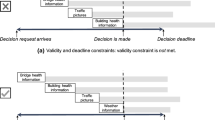Abstract
This paper describes the design and implementation of a hierarchical scheduling subsystem and graphical user interface in an intelligent environmental control system. The hierarchical scheduling system is capable of managing all environmental events occurring in widely different time scales as specified by the user. We employ a knowledge representation scheme called a system entity structure to specify the environmental schedules in a hierarchical fashion. A system entity structure called TAL (Timed Action Language) is developed. TAL organizes a family of all possible long-/mid-/short-term schedules from which a specific schedule can be pruned by the user through graphical interface.
Similar content being viewed by others
References
Hoshi, T. and Kozai, T.: Knowledge-based and hierarchically distributed online control system for greenhouse management, Acta Horticulture 148, 301–303 (1984).
Jacobson, B.K., Jones, J.W., and Jones, P.: Tomato greenhouse environment controller: real-time expert system supervisor, ASAE Technical Paper No. 87-5022 (1987).
Kim, Tag Gon: A knowledge-based environment for hierarchical modelling and simulation, Doctoral dissertation, Electrical and Computer Engineering Dept., University of Arizona, Tucson, AZ (1988).
Kim, Tag Gon, Mignon, G., and Zeigler, B.P.: Design of an AI-based self-sustaining habitats control system, Proc. First Internat. Conference on Industrial & Engineering Applications of Artificial Intelligence & Expert Systems, Tullahoma, Tennessee (1988), pp. 1059–1065.
Kim, Tag Gon and Zeigler, B.P.: Hierarchical scheduling in an intelligent environmental control system, Proc. Second International Conference on Industrial & Engineering Applications of Artificial Intelligence & Expert Systems, Tullahoma, Tennessee (1989).
Kim, Tag Gon and Zeigler, B.P.: ESP-scheme: a realization of system entity structure in a LISP environment, Proc. AI and Simulation of 1989 SCS Eastern Multiconference, Tempa, Florida (1989).
Kim, Tag Gon: Design of intelligent control system: vol. I, Tech. Report, ER Lab., University of Arizona (1988).
Saridis, George N.: Knowledge implementation: structures of intelligent control systems. Proc. IEEE International Symposium on Intelligent Control, Philadelphia, PA (1987).
Schapendonk, A.H.C.M., Challa, H., Broekharst, P.W., and Udink ten Cate, A.J.: Dynamic climate control: an optimization study for earliness of cucumber production, Scientia Horticulturae 23, 137–150 (1984).
TI Scheme Language Reference Manual, Texas Instruments, Dallas, TX (1985).
Udink ten Cate A.J. & Challa H.: On optimal computer control of the crop growth system, Acta Horticulture 148, 267–276.
Zeigler, B.P.: Multifaceted Modelling and Discrete Event Simulation, Academic Press, New York (1984).
Zeigler, B.P.: Knowledge representation from Minsky to Newton and beyond, Applied Artificial Intelligence, vol. I, Hemisphere Pub., Co. (1987), pp. 87–107.
Author information
Authors and Affiliations
Additional information
Research was done while the author was a member of the Environmental Research Lab, University of Arizona. A Preliminary version of the paper was presented at 2nd International Conference on Industrial & Engineering Applications of AI and Expert System [5].
Rights and permissions
About this article
Cite this article
Kim, T.G. Hierarchical scheduling in an intelligent environmental control system. J Intell Robot Syst 3, 183–193 (1990). https://doi.org/10.1007/BF00242164
Received:
Issue Date:
DOI: https://doi.org/10.1007/BF00242164




